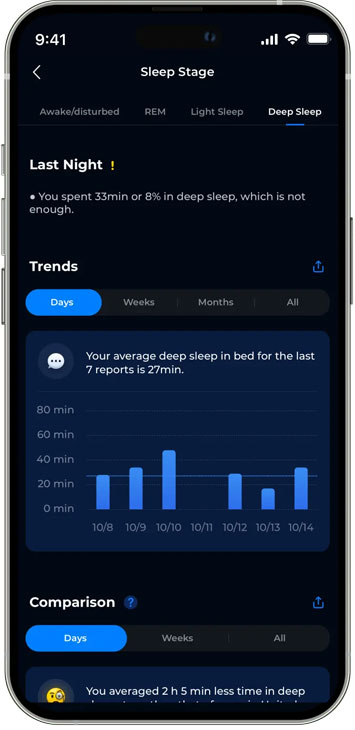How a Sleep Diary Can Help You Identify Sleep Problems

Quality sleep is essential for overall health, yet many people struggle to get enough of it. If you frequently wake up feeling tired or groggy, tracking your sleep habits may provide valuable insights.
One effective way to do this is by keeping a sleep diary. By recording your sleep patterns, you can calculate sleep time accurately and uncover potential disruptions that may be affecting your rest. This simple practice can help identify sleep issues and guide you toward better habits for improved well-being.
Keep on reading to learn how a sleep diary can help you recognize sleep disturbances and how combining it with a sleep app can provide even more valuable insights.
What Is a Sleep Diary?
A sleep diary is a tool used to track and monitor sleep patterns over a set period. It typically includes details such as bedtime, wake time, night awakenings, sleep quality, and daily habits that may influence sleep. Recording this information consistently can help pinpoint recurring issues that could be interfering with your rest.
Many healthcare professionals recommend keeping a sleep diary for at least two weeks. This allows for enough data collection to identify trends or inconsistencies. If sleep problems persist, a sleep diary can serve as a useful reference when consulting a doctor or sleep specialist.
How a Sleep Diary Helps Identify Sleep Problems
Tracking sleep through a diary provides insights into various aspects of your sleep routine. By reviewing your entries, you can detect patterns that may contribute to poor sleep quality. Here are some common sleep issues a diary can help uncover:
Inconsistent Sleep Schedules
A well-regulated sleep schedule is crucial for maintaining a healthy circadian rhythm. A sleep diary can highlight irregularities in your bedtime and wake time, which may be affecting your sleep consistency. If you go to bed and wake up at different times every day, your body may struggle to establish a stable sleep cycle, leading to fatigue and difficulty falling asleep.
Nighttime Awakenings
Frequent night awakenings can severely disrupt sleep quality. Your sleep diary can help identify when and how often you wake up during the night. Noting any patterns—such as waking up at the same time each night—may enable you to uncover underlying causes, such as stress, discomfort, or external disturbances like noise or temperature fluctuations.
Poor Sleep Quality
Even if you’re getting enough hours of sleep, poor sleep quality can leave you feeling exhausted. Your sleep diary can help determine whether your rest is truly restorative. Describing how you feel upon waking up and throughout the day can reveal whether your sleep is deep and uninterrupted or light and restless.
Lifestyle and Environmental Factors
Certain lifestyle habits and environmental factors can impact sleep without you realizing it. A sleep diary allows you to track elements such as caffeine and alcohol consumption, exercise routines, screen time before bed, and sleeping conditions. Analyzing this information can help you make adjustments to improve sleep hygiene.
Using a Sleep App Alongside a Sleep Diary to Enhance Sleep
 While a traditional sleep diary is valuable, using a sleep app alongside it can provide even deeper insights into your sleep patterns. A sleep app can track movement, breathing patterns, and other data that may be difficult to record manually.
While a traditional sleep diary is valuable, using a sleep app alongside it can provide even deeper insights into your sleep patterns. A sleep app can track movement, breathing patterns, and other data that may be difficult to record manually.
Many sleep apps offer features like automatic sleep tracking, smart alarms, and personalized recommendations. They analyze sleep duration, efficiency, and disturbances, making it easier to correlate diary entries with objective data. This combination can give a clearer picture of your sleep health and help identify any hidden issues.
For example, if your sleep diary notes that you wake up feeling groggy despite getting seven hours of sleep, a sleep app might reveal that much of your sleep was fragmented or spent in lighter sleep stages. With this information, you can adjust your habits to improve sleep depth and overall restfulness.
How to Start a Sleep Diary Effectively
Starting a sleep diary is simple, but consistency is key. To get the most accurate results, follow these basic steps:
1. Record your sleep details daily – include your bedtime, wake-up time, and any nighttime awakenings.
2. Note sleep quality – describe how you felt upon waking and throughout the day.
3. Track lifestyle factors – write down activities that might affect sleep, such as caffeine intake, alcohol consumption, and exercise.
4. Review your entries weekly – look for trends or recurring patterns that may indicate sleep problems.
5. Use a sleep app for additional insights – pair your diary with a sleep-tracking app to get more detailed data on sleep cycles and disturbances.
When to Seek Professional Help
If your sleep diary reveals ongoing issues despite making adjustments, it may be time to consult a healthcare professional.
Persistent problems such as chronic insomnia, excessive daytime fatigue, or breathing disturbances during sleep could indicate underlying health conditions that require medical attention.
A well-maintained sleep diary can provide useful information for doctors to assess your sleep health more effectively.
Conclusion
A sleep diary is a powerful tool for identifying sleep problems and improving overall sleep quality. Tracking sleep patterns and potential disruptions can aid you in gaining valuable insights into what may be affecting your rest. Pairing a sleep diary with a sleep app further enhances this process by providing objective data to complement your observations.
If sleep issues persist, consulting a professional with your sleep records can lead to effective solutions.
Prioritizing good sleep habits and monitoring your progress can help you achieve healthier, more restful nights.









